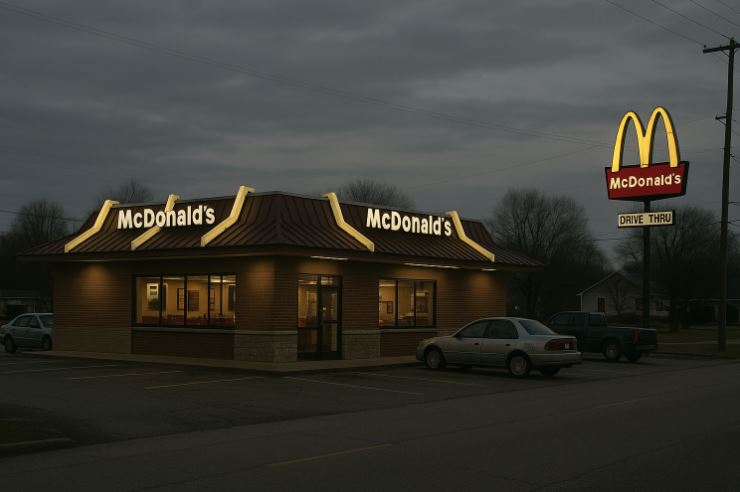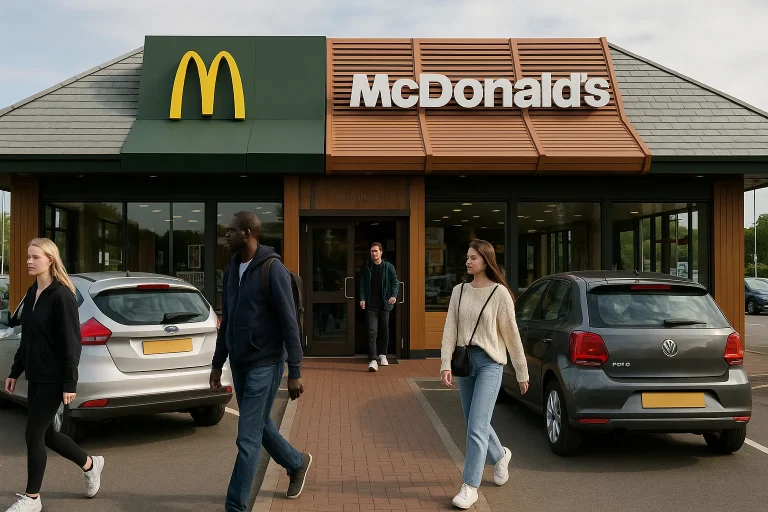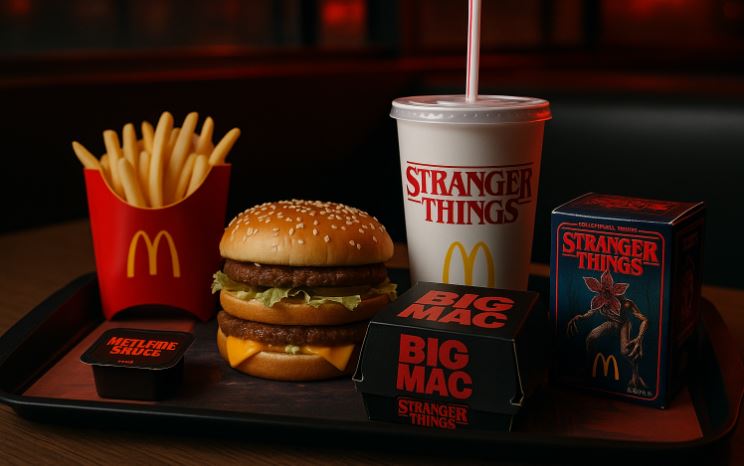In April 2004, a small-town McDonald’s in Mount Washington, Kentucky, became the centre of a shocking criminal hoax. An anonymous caller, posing as a police officer, manipulated staff into conducting a humiliating strip search of an innocent teenager.
What unfolded over the next few hours exposed deeply troubling psychological dynamics and corporate oversights.
This incident, though disturbing, prompted widespread discussions about authority, responsibility, and employee protection in the workplace across the fast-food industry and beyond.
What Was the Mount Washington McDonald’s Incident?

The Mount Washington McDonald’s incident refers to a disturbing event that occurred on 9 April 2004 in Mount Washington, Kentucky.
It involved an 18-year-old employee, Louise Ogborn, who was subjected to a strip search and prolonged sexual abuse in the restaurant’s office following a phone call from an individual claiming to be a police officer.
The caller, identifying himself as “Officer Scott,” convinced the assistant manager, Donna Summers, that Ogborn had stolen money from a customer.
What followed was a harrowing sequence of events in which multiple people participated in the abuse, all under the apparent authority of a non-existent law enforcement officer.
This case quickly became infamous and served as a shocking example of the dangers of blind obedience to authority and manipulation in the workplace.
Who Was Behind the Strip Search Phone Scam?
The Mount Washington case was not an isolated event. It was part of a larger pattern known as the “strip search phone call scam,” a hoax that had been unfolding in the United States since at least 1994.
The scam typically targeted fast food chains and involved a man calling and impersonating a police officer. He would instruct managers to detain and search employees, usually young women, for alleged crimes like theft or drug possession.
More than 70 similar calls were reported across 30 states. The man believed to be behind the majority of these incidents was David Richard Stewart, a security guard from Florida.
Although Stewart was eventually arrested in connection with the Mount Washington case, he was acquitted in 2006 due to insufficient evidence. However, the scam calls stopped after his arrest, suggesting his likely involvement.
How Did the Incident Unfold Inside the McDonald’s Office?
On that April afternoon, Louise Ogborn was brought into the McDonald’s office. Following the caller’s instructions, Summers asked Ogborn to remove her clothing and placed it in her car. Ogborn was left wearing only an apron.
Initially, another assistant manager, Kim Dockery, was present but left after an hour. With Dockery gone, the caller told Summers to bring in someone she trusted to assist. She first turned to a cook, Jason Bradley, who refused to comply and left. Then she asked her fiancé, Walter Nix Jr., to step in.
What followed was deeply disturbing. Nix, under direction from the caller, forced Ogborn to perform degrading and abusive acts, including jumping jacks while naked, exposing herself, sitting on his lap, and ultimately performing oral sex. Summers periodically returned to the office during this time, unaware of the extent of the abuse.
Eventually, a maintenance worker, Thomas Simms, entered and refused to follow the caller’s instructions. His refusal led to Summers becoming suspicious, and after calling a senior manager, the hoax was finally uncovered.
Why Didn’t Anyone Stop the Hoax Sooner?

The Mount Washington incident raised important questions about authority, compliance, and human behaviour. How could multiple adults have followed such unthinkable instructions from an anonymous caller?
Psychologists linked this incident to the Milgram experiment, a 1960s study demonstrating that people tend to obey authority figures, even when asked to do things that conflict with their morals. The caller exploited this psychological tendency, slowly escalating the requests until the participants were so deeply involved that they felt unable to stop.
This case also highlights the bystander effect and a lack of critical questioning in high-pressure work environments.
What Were the Legal Outcomes for the People Involved?
Walter Nix Jr. was arrested and pleaded guilty to charges including sexual abuse and unlawful imprisonment. He received a five-year prison sentence.
Donna Summers was dismissed from McDonald’s for violating company policy and later entered a guilty plea to unlawful imprisonment, resulting in probation. David Stewart, believed to be the mastermind behind the calls, was acquitted at trial due to the lack of a direct link, such as a voice recording. Despite the acquittal, police confirmed that similar calls ceased after his arrest.
How Did McDonald’s Respond to the Scandal?
McDonald’s faced heavy criticism for its handling of the situation. During the trial, it was revealed that the company had knowledge of similar incidents at other locations and had failed to adequately inform or train staff to handle such hoaxes.
As a result of the lawsuit brought forward by Louise Ogborn, a jury awarded her over $6 million in damages. Donna Summers also received a partial award. McDonald’s appealed some of the rulings but ultimately agreed to settle.
In response, the company updated its manager training programmes, incorporating education about scams, employee rights, and protocols to prevent similar situations from recurring.
What Are the Psychological Lessons from This Incident?

This incident has been studied extensively in psychology and criminology circles. It serves as a stark reminder of the power of perceived authority and how ordinary individuals can be manipulated into carrying out harmful actions.
The incident also underlines the importance of critical thinking and ethical training in the workplace. Businesses must empower employees to question unusual instructions, even when they appear to come from law enforcement or upper management.
How Has the Incident Been Portrayed in Media and Pop Culture?
The Mount Washington incident has inspired numerous adaptations and discussions in media. The most well-known is the 2012 film Compliance, which depicted a fictionalised version of the events. While praised for raising awareness, the film also sparked debate about its graphic content.
Other portrayals include:
- An episode of Law & Order: SVU featuring Robin Williams as the caller
- Podcasts such as Casefile and My Favorite Murder
- The 2022 Netflix docuseries Don’t Pick Up The Phone
These representations continue to fuel public interest and debate about how such an event could happen.
What Can Businesses Learn from the Mount Washington Incident?
This case is a cautionary tale for all employers. It demonstrates the importance of:
- Training staff to handle unusual or suspicious instructions
- Creating a workplace culture that empowers employees to question authority when needed
- Ensuring that policies against strip searches or similar actions are clear and enforced
- Providing support structures such as HR departments and whistleblower lines
Conclusion
The Mount Washington McDonald’s incident remains a haunting example of how authority can be dangerously misused. It forced companies to re-evaluate internal policies and highlighted the psychological vulnerability of individuals under pressure.
Though the caller was never conclusively linked, the abuse suffered by Louise Ogborn left a lasting impact on public awareness and corporate training.
Understanding what happened isn’t just about recounting a crime, it’s about ensuring such exploitation never happens again in any workplace setting.
FAQs
What was the goal of the strip search scam caller?
The caller sought to exploit authority and manipulate people into committing abusive acts under the belief that they were helping police investigations.
Was David Stewart ever proven guilty?
David Stewart was arrested and tried in connection with the Mount Washington case but was acquitted due to lack of direct evidence linking him to the calls.
How did Louise Ogborn cope after the incident?
Louise Ogborn suffered from post-traumatic stress disorder and depression. She left university and underwent therapy to recover from the psychological impact.
What changes did McDonald’s make after the incident?
McDonald’s revised its corporate training policies to better prepare managers to handle hoax calls and to prevent similar abuse in the future.
Why did employees comply with such outrageous instructions?
The caller exploited obedience to authority, a phenomenon studied in psychology, leading employees to follow orders even when they were unethical.
Is the movie Compliance a true story?
Compliance is based on the Mount Washington incident but is a fictionalised retelling meant to highlight the psychological elements involved.
How can employees protect themselves from workplace scams?
Employees should be trained to question unusual requests, verify identities of callers, and report suspicious instructions to upper management or law enforcement.




